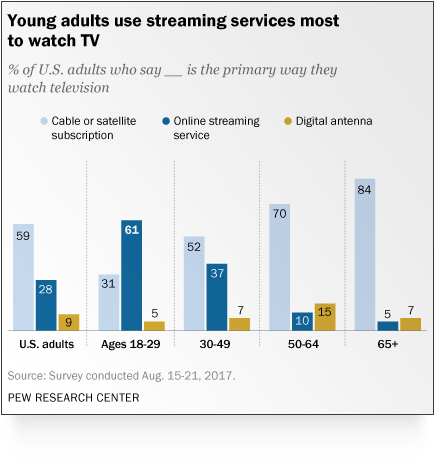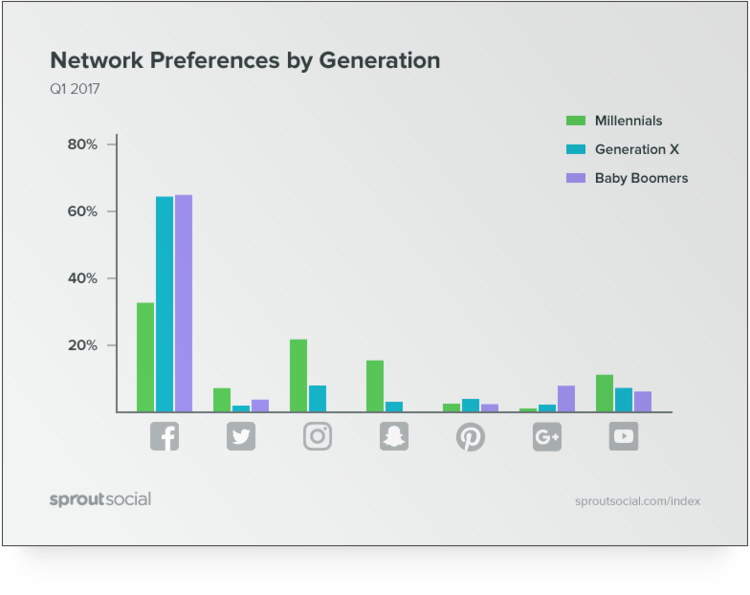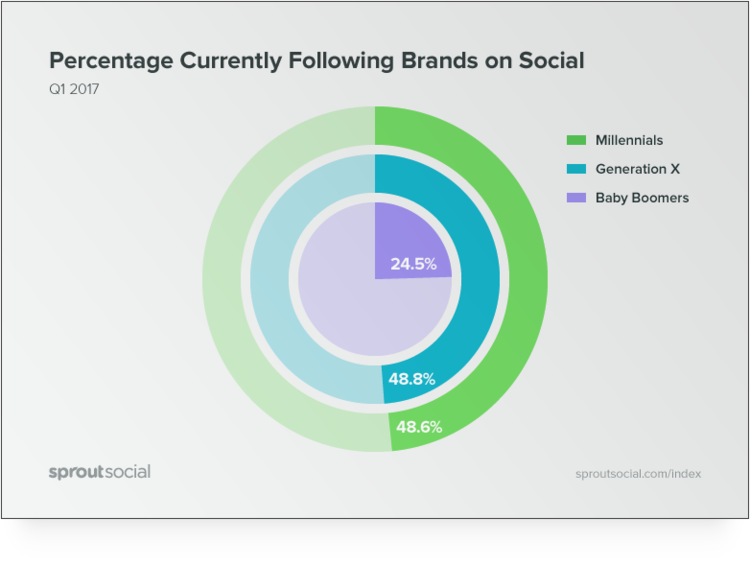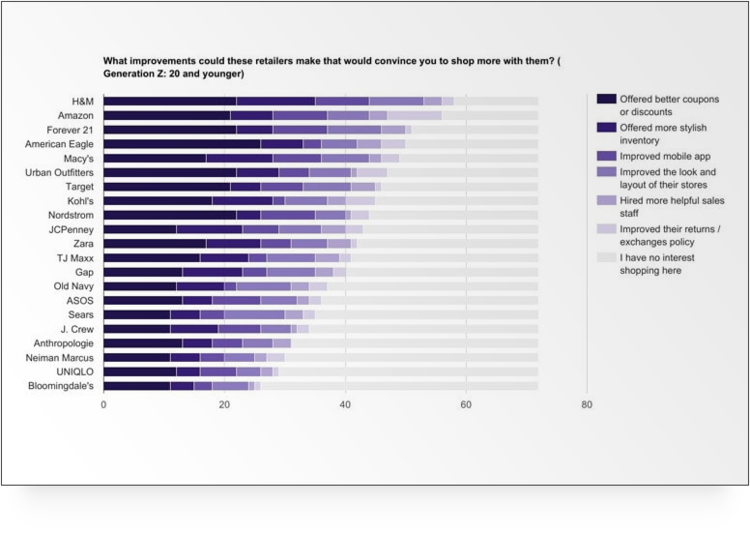How Gen X Moms and Gen Z Teens Use Social to Make Buying Decisions (Back-to-School Edition)
Back-to-school marks the unofficial start of the year-end shopping season. There are probably very few people who see the start of classes as some sort of big spending holiday, even the parents doing the spending.
But you buy enough 24-count boxes of crayons for 50 cents, and composition notebooks for a quarter (and the obligatory device upgrade), and you will soon have enough supplies (and devices) to count school shopping among the most expensive events of the year.
A Replay of What Makes Late Summer the Start of the Winter Holiday Season
In our first post, we looked at the numbers that substantiate this idea of back-to-school shopping launching us into the big spending holidays. And we introduced the first two of four avatars doing the spending this holiday season (or influencing those who do). Here’s a quick review:
The average American family will spend more than $500 on school supplies, computers, devices, and school clothes at the start of the school year, and surpass more than $29 billion in back-to-school spending. And that’s just for K-12 families.
For parents who have kids heading back to college, that segment of back-to-school shoppers spends nearly twice as much as the K-12 crowd, shelling out $54.1 billion. That means parents and students spend somewhere around $83 billion just on back-to-school shopping.
Let’s give this a little perspective.
According to the World Bank, $83 billion exceeds the Gross Domestic Products for 130 out of the 195 countries in the world today.
Back-to-school shopping is the second biggest shopping event of the year, bested only by Christmas shopping. But compared to Christmas, the amount of money we spend sending our kids back to school is less than 10 percent of what Americans spend come Christmas time.
Great. People spend money during the holidays. What’s new?
What’s new is that according to Nielsen, 39 percent of heavy social media users (those on social 3+ hours a day) believe social is THE place to go when they want to find out about products and services.
That’s why your influencer marketing campaign needs to start today. In addition to giving you the lay of the land with today’s post, we’ll show you:
- How to identify influencers
- How you can propose partnerships
- How to choose the right success metrics for your campaign, and
- How to launch your influencer marketing campaign
In my last post, I ran the profiles of Millennial Moms and their beloved Gen Alpha children. This week, the big spenders we’re targeting are Gen X Moms and Gen Z teens and preteens.
Gen X Moms
WHO THEY ARE
Born between 1965 and 1980 Gen X Moms are a little hard to peg for most marketers. Having been virtually defined by Boomers as “slackers” in their youth for graduating college just as jobs were flying overseas, and formulating the collective consciousness that made Nirvana’s Never Mind the soundtrack of a generation, people… and marketers… still think of Gen Xers as deliberately disconnected.
There’s a good reason for that.
While Boomers were defined by events like the Civil Rights Movement, Flower Power, and the birth of Women’s Liberation, Gen Xers grew up during the War on Drugs, the Gulf War, and the birth of the AIDS crisis.
Gen Xers are the nation’s first latch-key kids. Arriving home from school alone to make dinner and take care of younger siblings, Gen Xers played the role of parent daily in the hours before their actual parents made it home from work. They came of age during a time when divorce rates peaked (around 1980) and kids had to choose a side.
They experienced the misfortune of trying to build lifelong careers like their Boomer parents at a time when globalization and outsourcing made it possible for workers halfway around the globe to take their jobs.
Job security disappeared, and pensions became a relic of the good old days.
Understandably, Gen Xers earned a reputation for being fiercely independent, resourceful, rebellious, and a little disconnected from the ideals that defined their community-minded Baby Boomer parents. As well, they sort of shun the ideals that are defining their tech-driven, global-community-minded Millennial offspring.
That said, let’s take a leering look at Gen X Moms. The 65 million Americans who make up Generation X include a brigade of moms who laid the foundation for how and if their kids would engage with the Internet. These women are the overworked, well-paid bridge that connects their aging Boomer parents and their maturing (fingers crossed) Millennial and Gen Z children.
Marketers largely overlook them because they have a hard time figuring out how and where to market to women who have become accustomed to going it alone.
And while Boomer Moms and Millennial Moms may sing Kumbaya louder than Gen X Moms (let’s face it, Gen X Moms probably aren’t interested in holding hands and singing with you anyway), Gen X Moms are shaping the workplace, politics, and society almost completely undetected.
HOW THEY USE SOCIAL
According to a post in Adweek, Gen X Moms are just as likely to listen to the radio (48 percent) and read a newspaper (62 percent) as they are to stream music and read a newsfeed.
Part of what makes it such a challenge for marketers to reach Gen X Moms is that Gen Xers have their feet planted firmly on the line that separates old school from new school, and are fluent in both.

Source: Pew Research
Yes, 85 percent of Gen Xers have a favorite TV show, but Gen X Moms are also heavy social media users. In fact, adults 35 to 49 year of age spent an average of 6 hours and 58 minutes a week on social networks, compared to Millennials, who spent 6 hours 19 minutes a week on social.
As for those television programs, the drama of TV ends up being fodder for social media posts. Of those surveyed, 42 percent of the folks using Facebook on a second screen while watching television were Gen Xers, ages 35 to 49.
In fact, 84 percent of Gen Xers surveyed said they use multiple devices (TV, smartphones, and laptops) during the prime time hours of 7PM to 11PM.
Gen X Moms also use social to follow the brands they like, though they are not necessarily in the habit of positioning themselves as social influencers like Millennial Moms.
Gen X Moms use social media as a way to “stay in the loop” with their favorite brands and keep up with contests and deals. Gen Xers also use social as a way to engage with the brands they follow (goodbye 1-800 numbers and “support@” email addresses).
Gen Xers tend to be more loyal to their favorite brands than either Boomers or Millennials are to their preferred brands. They are almost twice as likely to follow a brand on social media than Boomers, but they’re quick to unfollow if a company gets spammy, offensive or just annoying in general.

HOW THEY SHOP
Like Millennials, most Gen X moms work outside the home. Seventy-five percent of Gen Xers earn more than Boomers did at their age. The catch is they have more debt, so their net worth is less than that of their parents.
Nevertheless, when it comes to spending, Gen Xers are the heavyweights. They make up a quarter of the population, and account for 31 percent of consumer spending, even with 29 percent of Gen X women being the primary breadwinners in their households.
Gen Xers make it a point to follow a brand’s social media activity before buying from them more than half the time. In the end, nearly 7 in 10 Gen Xers who do follow a brand on a social network will buy from that brand, according to “The Social Generations: Millennials Ask, Gen X Buys, & Baby Boomers Observe” post published by Sprout Social.

Gen Z
WHO THEY ARE
Born between approximately 1997 and 2010 (some estimates extend that period to 2016), Generation Z kids are the offspring of Gen Xers, Millennials, and yes, Mick Jagger. The oldest Generation Z kids are in college and preparing to enter the workforce while younger members of Generation Z are still in elementary school.

The members of Generation Z make up a quarter of the US population, and in just two more years, they could account for up to 40 percent of all consumers, according to Fast Company. Most of them are still young enough to get an allowance, the sum total of which comes to about $44 billion a year. Nothing to sneeze at. And like their Gen Alpha younger siblings, they have a say in how their Millennial and Gen X parents spend the $600 billion they control, chiming in on everything from breakfast foods to which family homes to buy.
Nearly half of all Gen Zers (48 percent) are non-white, which is why we counted them in the last post as the most diverse generation in America, and definitely the first to be a majority non-white. Some reports include Gen Alpha as a subset of Generation Z. For the purposes of this series, we’ve separated the generation into three distinct groups:
- Generation Alpha ages 7 and younger
- Generation Z Preteens, ages 8 to 12
- Generation Z Teenagers, ages 13 to 20
HOW GEN Z PRETEENS USE SOCIAL
Kids have gone digital. Traditionally, marketers set aside billions of dollars in ad spend to reach kids via broadcast and cable television. But the days of after-school shows and Saturday morning cartoons are long gone.
Today, preteens are more interested in consuming their multimedia content in bite-sized chunks, and doing it on demand. So, it makes sense that the preferred social network for kids under the age of 13 is YouTube.
Not only is YouTube a popular social channel, but YouTube earned the distinction of being voted the Most Love Brand in Smarty Pants LLC’s “Brand Love” study for the second year in a row. The study, which polled more than 8,000 kids ages 6 to 12, discovered YouTube’s influence over kids is surprisingly stronger than several heavyweights, including Oreo cookies, Lego, McDonalds, Hershey’s, M&M’s, fidget spinners, and Toys R Us (RIP).
That means on-demand videos beat out toys and candy for best thing ever with Gen Z Preteens. This trend toward having access to tons of multimedia content even amongst kids is why Cisco VNI predicted 80 percent of the web’s traffic will be video by 2019, according to Marketing Dive.
Nielsen reports TV viewership is down 50 percent for kids between the ages of 2 years and 11 years old, but it’s unclear whether that’s because kids are watching TV only half as much, or if it’s because only half the kids are watching TV at all.
In response to this shift away from traditional TV, marketers are expected to spend $1.2 billion on digital advertising directed at Gen Z preteens by 2019 according to PwC. In addition to the original programming for Netflix and YouTube, BBC also plans to invest $44 million in children’s programming between now and 2020.
HOW GEN Z TEENS USE SOCIAL
Gen Z teens are in the unique position of being born into brand strategy as a way of life. They are simultaneously managing their live persona and balancing it against their online persona, while carefully curating content that will positively position them for both college and the job market in the years to come.
Only 49 percent of Gen Zers admit social media is an important part of their lives, but they can’t deny they get a certain amount of validation from the hard work they put into maintaining pristine social media profiles.
The typical Gen Zer who uses social media has already learned how to masterfully present their different social media personas in accordance with the culture of each platform they’re using. And yes, this is the kind of work Gen Xers and Boomers pay SMM agencies to do for them.
Three-quarters of teens ages 13 to 17 identify Instagram and/or Snapchat as their go-to social media platform. While more than 90 percent of teens use the messaging function on their phones to socialize, 40 percent also add messaging apps like Whatsapp to their phones to socialize.
Gen Z teens are commonly referred to as the generation that grew up on smartphones, but don’t forget this generation is also old enough to remember flip phones.
Lots of the older Gen Z teens in high school and college can probably remember when laptops were strictly for Mom and Dad’s work, tablets didn’t exist for them outside of Leap Frogs and Etch-a-Sketches, and the not-so-smart but oh-so-common flip phones were the phone all their friends used.
After all, not many parents were lining up to buy their fifth grader a $600 iPhone when Apple first introduced them to the world.
Today, 89 percent of teens use smartphones, and 80 percent use laptops; 68 percent of teens have access to a tablet versus 54 percent of teens who now have access to a desktop computer.
HOW TEENS SHOP
Now, before we get into how Gen Z shops when they hit the stores, there are a couple of interesting traits that have emerged in this group that we want to point out.
First, Gen Z members are not brand-loyal like their Gen X parents. In fact, they’ve been referred to as less trusting of brands than any generation before them. They are far less brand-conscious and would rather take the word of their favorite social media influencer over even the most elaborate and polished 60-second spot. They don’t want to know your brand story unless it directly fits in with, and springs from, their existing interests.
They have honed the ability to identify good content vs bad content (or valuable content vs everything else) in just 8 seconds. As a marketer, you have 8 seconds to make an impression that will result in something other than a screen-swipe or a click-away.
Third, Gen Zers don’t seem to be very patriotic. Terrible news for the Captain America franchise. When asked, 68 percent of Gen Z teenagers said they feel the US is moving in the wrong direction.
Now that those three points are out of the way, we can talk about how teens spend their money.
Food.
The Taking Stock with Teens Spring 2017 study from Piper Jaffray reported 24 percent of Gen Z teenagers spend their money – whether earned or not – on fast food purchases, and their favorite places to spend are Chic-Fil-A and Starbucks.
Their next big purchase is clothes at 19 percent of their total budgets. Boys are more likely to go for brands than girls, who are more interested in finding the right styles irrespective of brand name, according to Mediapost. And like men, teenage boys tend to shop based on a specific need, as opposed to girls who are more impulse-driven and tend to shop based on their budget, not their needs.
Both male and female Gen Z buyers are more likely to buy clothes in-store after browsing online, according to Fashion United. Other popular spending categories for teens include:
- Cars (9 percent)
- Accessories and cosmetics (9 percent)
- Shoes (8 percent)
- Video games (8 percent)
- Electronics (7 percent)
Among the most beloved brands for teens, Amazon leads the pack followed by Nike. Teens seem to show a preference for apparel made by companies like Nike and Under Armour, that specialize in sportswear. In the Piper Jaffray survey, 41 percent of teens named an athletic brand as their favorite clothing brand. Adidas is also showing rapid growth among older Gen Zers. Other popular brands for teens include Converse, H&M, American Eagle, and Forever 21.

Source: Fashion United
As the observant bystanders in households where their Millennial siblings have had to move back in with Mom and Dad after college, Gen Z teens are learning the value of money, stability, and making good financial decisions. They are more financially cautious.
Frugal.
And more likely to save than Millennials were at the same age.
Let’s Build Some Campaigns
In the third and final part of this series, you’re going to get a 9-step summer influencer marketing plan that you can implement now and tweak in the coming months for fall and holiday campaigns. (You’re welcome, by the way). If you missed Part 1 of the 2018 Summer-Fall Marketing Plan, you can read that one by clicking here.
Now that you know the major stakeholders in the upcoming holiday shopping season, it’s time to start building some campaigns. In the next post, I’m going to lay out a 9-step influencer marketing plan that you can follow to launch a BOSS influencer marketing campaign.







